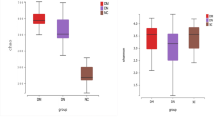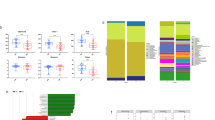Abstract
Aims
Type 2 diabetes mellitus (T2DM) has a rising prevalence and gut microbiota involvement is increasingly recognized. Diabetic nephropathy (DN) is a major complication of T2DM. The aim of the study was to understand the gut–kidney axis by an analysis of gut microbiota composition among biopsy-proven DN, T2DM without kidney disease, and healthy control.
Methods
Fecal samples were collected from 14 DNs, 14 age/gender-matched T2DMs without renal diseases (DM), 14 age and gender-matched healthy controls (HC) and household contacts (HH) of DM group. The microbiota composition was analyzed by 16sRNA microbial profiling approach.
Results
Substantial differences were found in the richness of gut microbiota and the variation of bacteria population in DM compared to HC, and DN compared to DM, respectively. DM could be accurately distinguished from age/gender-matched healthy controls by the variable of genus g_Prevotella_9 (AUC = 0.9), and DN patients could be accurately distinguished from age/gender-matched DM by the variables of two genera (g_Escherichia-Shigella and g_Prevotella_9, AUC = 0.86). The microbiota composition of HH group was close to that of HC group, and was different from DM group. Under the same diet, DM could be more accurately detected by the same genus (g_Prevotella_9, AUC = 0.92).
Conclusion
Gut microbiota composition was explored to be related to the occurrence of biopsy-proven DN from DM. DM could be distinguished from HC by detecting g_Prevotella_9 level in feces, while DN was different from DM by the variables of g_Escherichia-Shigella and g_Prevotella_9, which potentially contributed to the physiopathological diagnosis of DN from DM.




Similar content being viewed by others
References
Demmer RT, Zuk AM, Rosenbaum M, Desvarieux M (2013) Prevalence of diagnosed and undiagnosed type 2 diabetes mellitus among US adolescents: results from the continuous NHANES, 1999–2010. Am J Epidemiol 178(7):1106–1113
Ma RC, Lin X, Jia W (2014) Causes of type 2 diabetes in China. Lancet Diabetes Endocrinol 2(12):980–991
Pitts-Tucker T (2012) Asian and Afro-Caribbean Britons have double the risk of type 2 diabetes. Br Med J 345:e6135
Schellenberg ES, Dryden DM, Vandermeer B, Ha C, Korownyk C (2013) Lifestyle interventions for patients with and at risk for type 2 diabetes: a systematic review and meta-analysis. Ann Intern Med 159(8):543–551
Karlsson FH, Tremaroli V, Nookaew I et al (2013) Gut metagenome in European women with normal, impaired and diabetic glucose control. Nature 498(7452):99–103
Qin J, Li Y, Cai Z et al (2012) A metagenome-wide association study of gut microbiota in type 2 diabetes. Nature 490(7418):55–60
Zhang X, Shen D, Fang Z et al (2013) Human gut microbiota changes reveal the progression of glucose intolerance. PLoS One 8(8):e71108
de Vos WM, Nieuwdorp M (2013) Genomics. A gut prediction. Nature 498(7452):48–49
Lau E, Carvalho D, Pina-Vaz C, Barbosa JA, Freitas P (2015) Beyond gut microbiota: understanding obesity and type 2 diabetes. Hormones 14(3):358–369
Barsoum RS (2006) Chronic kidney disease in the developing world. N Engl J Med 354(10):997–999
Du P, Fan B, Han H et al (2013) NOD2 promotes renal injury by exacerbating inflammation and podocyte insulin resistance in diabetic nephropathy. Kidney Int 84(2):265–276
Zhang L, Long J, Jiang W et al (2016) Trends in chronic kidney disease in China. N Engl J Med 375(9):905–906
de Boer IH, Rue TC, Hall YN, Heagerty PJ, Weiss NS, Himmelfarb J (2011) Temporal trends in the prevalence of diabetic kidney disease in the United States. JAMA 305(24):2532–2539
Afkarian M, Sachs MC, Kestenbaum B et al (2013) Kidney disease and increased mortality risk in type 2 diabetes. J Am Soc Nephrol 24(2):302–308
Fineberg D, Jandeleit-Dahm KA, Cooper ME (2013) Diabetic nephropathy: diagnosis and treatment. Nat Rev Endocrinol 9(12):713–723
Li L, Ma L, Fu P (2017) Gut microbiota-derived short-chain fatty acids and kidney diseases. Drug Des Dev Ther 11:3531–3542
Ramezani A, Raj DS (2014) The gut microbiome, kidney disease, and targeted interventions. J Am Soc Nephrol 25(4):657–670
Cai L, Wu H, Li D, Zhou K, Zou F (2015) Type 2 diabetes biomarkers of human gut microbiota selected via iterative sure independent screening method. PLoS One 10(10):e0140827
Guo Z, Zhang J, Wang Z et al (2016) Intestinal microbiota distinguish gout patients from healthy humans. Sci Rep 6:20602
Vaziri ND, Wong J, Pahl M et al (2013) Chronic kidney disease alters intestinal microbial flora. Kidney Int 83(2):308–315
Levey AS, de Jong PE, Coresh J et al (2011) The definition, classification, and prognosis of chronic kidney disease: a KDIGO Controversies Conference report. Kidney Int 80(1):17–28
Bakris GL, Agarwal R, Chan JC et al (2015) Effect of finerenone on albuminuria in patients with diabetic nephropathy: a randomized clinical trial. JAMA 314(9):884–894
Brenner D, Hiergeist A, Adis C et al (2018) The fecal microbiome of ALS patients. Neurobiol Aging 61:132–137
Hiergeist A, Reischl U, Gessner A (2016) Multicenter quality assessment of 16S ribosomal DNA-sequencing for microbiome analyses reveals high inter-center variability. Int J Med Microbiol 306(5):334–342
Mcardle BH, Anderson MJ (2011) Fitting multivariate models to community data: a comment on distance-based redundancy analysis. Ecology 82(1):290–297
Zapala MA, Schork NJ (2006) Multivariate regression analysis of distance matrices for testing associations between gene expression patterns and related variables. Proc Natl Acad Sci USA 103(51):19430–19435
Chow J, Tang H, Mazmanian SK (2011) Pathobionts of the gastrointestinal microbiota and inflammatory disease. Curr Opin Immunol 23(4):473–480
Hooper LV, Littman DR, Macpherson AJ (2012) Interactions between the microbiota and the immune system. Science 336(6086):1268–1273
Sekirov I, Russell SL, Antunes LC, Finlay BB (2010) Gut microbiota in health and disease. Physiol Rev 90(3):859–904
Forslund K, Hildebrand F, Nielsen T et al (2015) Disentangling type 2 diabetes and metformin treatment signatures in the human gut microbiota. Nature 528(7581):262–266
De Angelis M, Montemurno E, Piccolo M et al (2014) Microbiota and metabolome associated with immunoglobulin A nephropathy (IgAN). PLoS One 9(6):e99006
Jiang S, Xie S, Lv D et al (2017) Alteration of the gut microbiota in Chinese population with chronic kidney disease. Sci Rep 7(1):2870
Poesen R, Windey K, Neven E et al (2016) The influence of CKD on colonic microbial metabolism. J Am Soc Nephrol 27(5):1389–1399
Nicholson JK, Holmes E, Kinross J et al (2012) Host–gut microbiota metabolic interactions. Science 336(6086):1262–1267
Chen T, Zhang X, Long Y et al (2012) The association of plasma free amino acids with liver enzymes in Type 2 diabetic patients. J Endocrinol Investig 35(8):772–775
Li M, Wang X, Aa J et al (2013) GC/TOFMS analysis of metabolites in serum and urine reveals metabolic perturbation of TCA cycle in db/db mice involved in diabetic nephropathy. Am J Physiol Renal Physiol 304(11):F1317–F1324
Nakamura H, Jinzu H, Nagao K et al (2014) Plasma amino acid profiles are associated with insulin, C-peptide and adiponectin levels in type 2 diabetic patients. Nutr Diabetes 4:e133
Scanlan PD, Shanahan F, Clune Y et al (2008) Culture-independent analysis of the gut microbiota in colorectal cancer and polyposis. Environ Microbiol 10(3):789–798
Vitali B, Ndagijimana M, Cruciani F et al (2010) Impact of a synbiotic food on the gut microbial ecology and metabolic profiles. BMC Microbiol 10:4
Sun L, Ma L, Ma Y, Zhang F, Zhao C, Nie Y (2018) Insights into the role of gut microbiota in obesity: pathogenesis, mechanisms, and therapeutic perspectives. Protein Cell 9(5):397–403
Andrade-Oliveira V, Amano MT, Correa-Costa M et al (2015) Gut bacteria products prevent AKI induced by ischemia-reperfusion. J Am Soc Nephrol 26(8):1877–1888
Wong J, Piceno YM, DeSantis TZ, Pahl M, Andersen GL, Vaziri ND (2014) Expansion of urease- and uricase-containing, indole- and p-cresol-forming and contraction of short-chain fatty acid-producing intestinal microbiota in ESRD. Am J Nephrol 39(3):230–237
Furusawa Y, Obata Y, Fukuda S et al (2013) Commensal microbe-derived butyrate induces the differentiation of colonic regulatory T cells. Nature 504(7480):446–450
Finegold SM, Dowd SE, Gontcharova V et al (2010) Pyrosequencing study of fecal microflora of autistic and control children. Anaerobe 16(4):444–453
Rizzatti G, Lopetuso LR, Gibiino G et al (2017) Proteobacteria: a common factor in human diseases. Biomed Res Int 2017(9):1–7
Wassenaar TM, Zimmermann K (2018) Lipopolysaccharides in food, food supplements, and probiotics: should we be worried? Eur J Microbiol Immunol 8(3):63–69
Carrero JJ, Stenvinkel P (2009) Persistent inflammation as a catalyst for other risk factors in chronic kidney disease: a hypothesis proposal. Clin J Am Soc Nephrol 4(Suppl 1):S49–S55
Croxen MA, Law RJ, Scholz R, Keeney KM, Wlodarska M, Finlay BB (2013) Recent advances in understanding enteric pathogenic Escherichia coli. Clin Microbiol Rev 26(4):822–880
Clark DP (1989) The fermentation pathways of Escherichia coli. FEMS Microbiol Rev 63(3):223–234
Liu J (2014) Ethanol and liver: recent insights into the mechanisms of ethanol-induced fatty liver. World J Gastroenterol 20(40):14672–14685
Mahmoodpoor F, Rahbar Saadat Y, Barzegari A, Ardalan M, Zununi Vahed S (2017) The impact of gut microbiota on kidney function and pathogenesis. Biomed Pharmacother 93:412–419
Funding
The study is supported by National Key Research & Development Program of China (2016YFC1305403), National Natural Science Foundation of China (81700634) and International cooperation project (2016HH0069) funded by Science and Technology Department of Sichuan Province.
Author information
Authors and Affiliations
Corresponding authors
Ethics declarations
Conflict of interest
The authors declare that they have no conflict of interest.
Ethical approval
Ethical approval was approved by Biomedical Ethics Committee of West China Hospital of Sichuan University (No. 2016-273). All the procedures followed the Declaration of Helsinki principles.
Informed consent
All participants provided written informed consent before enrolment in the study.
Additional information
Managed by Massimo Federici.
Publisher’s Note
Springer Nature remains neutral with regard to jurisdictional claims in published maps and institutional affiliations.
Electronic supplementary material
Below is the link to the electronic supplementary material.
Rights and permissions
About this article
Cite this article
Tao, S., Li, L., Li, L. et al. Understanding the gut–kidney axis among biopsy-proven diabetic nephropathy, type 2 diabetes mellitus and healthy controls: an analysis of the gut microbiota composition. Acta Diabetol 56, 581–592 (2019). https://doi.org/10.1007/s00592-019-01316-7
Received:
Accepted:
Published:
Issue Date:
DOI: https://doi.org/10.1007/s00592-019-01316-7




